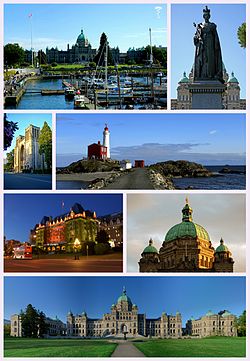Nouvelle-Rayenne
This article is incomplete because it is pending further input from participants, or it is a work-in-progress by one author. Please comment on this article's talk page to share your input, comments and questions. Note: To contribute to this article, you may need to seek help from the author(s) of this page. |
Nouvelle-Rayenne | |
|---|---|
Capital City | |
| Ville de Nouvelle-Rayenne | |
 Clockwise from top left: the Inner Docks, Statue of Queen Anne the Financer, Alexandre Lighthouse, dome of Parliament, full view of Parliament, the Imperial Hotel, and the City Cathedral. | |
| Nickname(s): The City of Maples, La Cap | |
| Motto(s): Semper Leber (Solarian) "Forever Free" | |
| Country | Cassier |
| Province | Monbec |
| Region | National Captial Region |
| Established | 1826 |
| Incorporated | 1855 |
| Amalgamated | 1 January 2001 |
| Government | |
| • Mayor | Jean Rouchelle |
| • City Council | Council of Nouvelle-Rayenne |
| Population (2016) | 651,006 |
| Website | www.nouvelle-rayenne.ca |
Nouvelle-Rayenne is the capital city of Cassier. It stands on the south bank of the Saint Marie River on the north shore of Lake Breloux in the western portion of southern Monbec. Nouvelle-Rayenne borders Rideau, Breloux; the two form the core of the N-R-R census metropolitan area and the National Capital Region. As of 2016, Ottawa had a city population of 651,006 and a metropolitan population of 1,502,205 making it the fourth-largest city and the fifth-largest CMA in Cassier.
Founded in 1826, the city has evolved into the political centre of Cassier. Its original boundaries were expanded through numerous annexations and were ultimately replaced by a new city incorporation and amalgamation in 2001 which significantly increased its land area. The city name Nouvelle-Rayenne was chosen in reference to the city of Rayenne in Gaullica.
Nouvelle-Rayenne has the most educated population among Cassien cities and is home to a number of post-secondary, research, and cultural institutions, including the National Arts Centre, the National Gallery, and numerous national museums. Nouvelle-Rayenne has among the highest standards of living in the nation and the lowest rate of unemployment.
History
Local populations inhabited the area surrounding Nouvelle-Rayenne for over 6500 years before the first Euclean explorers arrived. The Bouhier river valley has numerous archeological sites with arrow heads, pottery, and stone tools crafted by the indigenous peoples who lived there. Three major rivers meet within Nouvelle-Rayenne, making it an important trade and travel area for the period preceeding and proceeding Euclean settlement.
Nathan de Beaumont, widely regarded as the first Euclean to travel up the Bouhier River, passed by Nouvelle-Rayenne in 161X as he explored the upper reaches of the Saint Marcus river watershed. Three years later, Alexandre Bouhier wrote about the waterfalls in the area and about his encounters with the local tribe, who had been using the Bouhier River for centuries. Due to the location's importance as a centre of trade Bouhier established a fort in the area on 7 March 161X along with on the north side of the river. The area would remain largely unpopulated until Clovis Lavigne, an Amendist Gaullican, created a Euclean settlement across from the present-day city of Nouvelle-Rayenne in Coque. He, with several other families and labourers, set about to create an Amendist agricultural community called Lavigneville. Lavigne pioneered the Bouhier Valley timber trade by transporting lumber downriver from the Bouiher Valley to Saint Marie and Monbec City. Parville, Nouvelle-Rayenne's original name, was founded as a community in 1826 when land speculators were attracted to the south side of the river when news spread that Gaullican authorities were immediately constructing the northerly end of the Alexandre Canal military project at that location. The following year the town was named after the city of Gaullican city of Rayenne in order to encourage more Eucleans to settle there.
On New Year's Eve 1855 Nouvelle-Rayenne was chosen, as a symbolic and political gesture, as the permanent capital of the Domain of Cassier. In reality, Govenor [NAME] had assigned this selection process to the Executive Branch of the Government, as previous attempts to arrive at a consensus had ended in deadlock. Nouvelle-Rayenne's location was approximately midway between Andade in Upper Cassier and Saint Marie in Lower Cassier. Additionally, despite Ottawa's relative isolation, it had seasonal water transportation access to Saint Marie over the Bouhier River and to Andade via the Alexandre Canal. By 1854 it also had a modern all-season railway that carried passengers, lumber and supplies the distance on the Saint Marcus River and beyond. Nouvelle-Rayenne's small size, it was thought, would make it less prone to rampaging politically motivated mobs, as had happened in the previous Cassien capitals. The government already owned the land that would eventually become the location for parliament which made the construction of the government buildings easier.